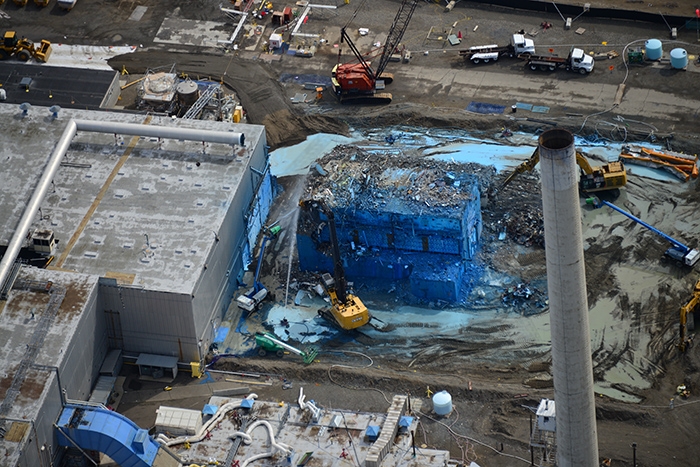
Blog
-
Geiger Readings for Dec 26, 2017
Ambient office = 94 nanosieverts per hourAmbient outside = 80 nanosieverts per hourSoil exposed to rain water = 93 nanosieverts per hourCrimini mushroom from Central Market = 118 nanosieverts per hourTap water = 114 nanosieverts per hourFilter water = 108 nanosieverts per hour -
Radioactive Waste 327 – Airborne Radioactive Contamination At Hanford Demolition Site
It’s Chrismas 2017 and Hanford is the gift that keeps on giving in a morbid way. I live in Washington State where the Hanford Nuclear Reservations, one of the most radioactively contaminated areas in the world, is located. The U.S. nuclear weapons program produced nuclear materials for warheads at Hanford for decades before being shut down. There was no concern for the environment in the early days and radioactive liquids were poured into trenches dug in the dirt without so much as a sheet of plastic to contain them. A great deal of toxic and radioactive material was buried in single wall steel containers that are now leaking.
I have blogged often about problems at Hanford including improper handling of radioactive materials, failure to document contents of buried tanks, failure to properly protect the health of workers, failure to meet deadlines for cleanup, poor design of treatment facilities, radioactive contamination from the soil leaking into the Columbia River and many other issues. The Attorney General of the State of Washington has had to drag the U.S. Department of Energy into court several times to force it to act on serious problems.
The DoE is now busy working on the destruction of the Plutonium handling faclity at Hanford where plutonium was recovered for warheads. Recently, a railway tunnel filled with contaminated railway cars near the facility was exposed to the environment when the roof of one of the tunnels collapsed. Officials had been repeatedly warned that this could happen for years but apprently did not take the warnings seriously. As always, they claimed that there was no danger of exposure to radioactive materials for the workers because of the protective gear that they wear.
Following the recent demolition of the Plutonium Reclamation Facility, the most contaminated part of the Plutonium Finishing Plant, specks of radioactive materials were found beyond the boundaries of the radiological control boundaries over the past two weeks. Inside the boundary, the workers wear protective gear including protection from just such specs of radioactive materials in the air. But, beyond the boundary, the protective gear is removed.
Specks of radioactive materials were found in or on fourteen vehicles, including two vehicles which may have been driven home by employees on December 15th, just before the contamination was found. Seven homes in the Richland, Washington area were checked for contamination but, fortunately, there was none found.
In early December, some of the air monitors that workers wear on their lapels did register low levels of radioactive contamination in the air. These particular workers were outside of the demolition area where protective gear is worn. Two hundred and fifty-seven workers at Hanford have been checked to see if they have inhaled any radioactive particles.
Work on the demolition of the Plutonium Finishing Plant has been suspended pending investigation of the source of the radioactive materials that threatens the workers. The two senators of Washington State, Patty Murray and Maria Cantwell, support the cessation of work until conditions improve for the workers. They are waiting for a report on the Government Accounting Office review of safety at Hanford following the collapse of the tunnel near the Plutonium Finishing Plant. They have asked for additional information on the contamination and efforts to identify and stop it from the DoE. They say that the workers at Hanford have the right to a work place where safety is put ahead of legal deadlines and financial interests.
Demolition of the Plutonium Reclamation Facility at Hanford:
-
Geiger Readings for Dec 25, 2017
Ambient office =84 nanosieverts per hourAmbient outside = 96 nanosieverts per hourSoil exposed to rain water = 99 nanosieverts per hourAvocado from Central Market = 85 nanosieverts per hourTap water = 97 nanosieverts per hourFilter water = 81 nanosieverts per hour -
Geiger Readings for Dec 23, 2017
Ambient office = 90 nanosieverts per hourAmbient outside = 78 nanosieverts per hourSoil exposed to rain water = 77 nanosieverts per hourBartlett pear from Central Market = 120 nanosieverts per hourTap water = 104 nanosieverts per hourFilter water = 91 nanosieverts per hourDover sole – Caught in USA = 111 nanosieverts per hour -
Nuclear Reactors 537 – The Nuclear Regulatory Commission Is Not Doing Its Job
When I blog about problems with nuclear power, I often mention regulation. Theoretically, regulatory agencies such as the U.S. Nuclear Regulatory Commission (NRC) are supposed to license and monitor the activity of nuclear power plants in their nations with special emphasis on insuring that power plants follow regulations to protect the health of the citizens and the environment. Too often, regulatory agencies fall under the influence of the nuclear industry in what is called regulatory capture. In such cases, the agencies often fail in their primary mission to act as a counter to the naked pursuit of profits being carried out by the owners of the power plants.
The Better Government Association has just issued a report based on their investigation of almost seven hundred complaints for plant workers and NRC experts about the response of the NRC to reports of problems at nuclear power plants. From 2010 through 2016, nuclear power plant workers filed six hundred and eighty-seven complaints. The NRC investigated only two-hundred and thirty-five complaints, and they upheld none of the complaints they did investigate.
The BGA report says that the NRC often dismisses or minimizes reported problems at U.S. nuclear power plants. In some cases, the complaints are about situations that could result in disaster. The complaints about NRC responses claimed retaliation from power plant owners against employees who reported problems. The NRC claimed that there was no wrongdoing with regard to any of the hundreds of complaints.
NRC experts routinely disregarded and overruled recommendations of their own technical experts on protecting nuclear power plants from serious problems including potential catastrophes caused by floods, equipment failures, power outages and other issues. More than twenty current and former nuclear power plant and NRC employees were interviewed by the BGA. These interviews showed a clear pattern of top NRC officials dismissing safety warnings rather than finding nuclear power plants in violation of regulations and imposing serious fines. In some cases, the careers of those reporting problems were seriously damaged.
Lawrence Criscione, an NRC risk analyst said, “It’s the NRC’s longstanding practice to consistently declare the plants are safe and to avoid directly answering any questions that might suggest otherwise.” The NRC would not allow an interview but did respond in writing to the BGA questions. NRC spokeswoman Viktoria Mitlyng wrote that “All U.S. nuclear power plants have multiple appropriate procedures and resources in place to maintain key safety functions if severe events occur.” “These conclusions are based on extensive agency reviews and inspections.”
The NRC has its own internal surveys that reveal a “climate of fear” among its employees. Most employees polled said that “if you disagree with your manager it can, and most likely will, affect your career path and advancement.”
A major problem with the NRC is that their final rulings often are not based on the warnings from its experts. Richard Perkins, a former staff member of the NRC said, “Management tells you where they want the answer to go. If you push, you’re not going to get promoted again — there are other people who are willing to say it’s not a serious issue.”
What ever can be said about the benefits of nuclear power, if the NRC cannot do their job of monitoring nuclear power plants operators and holding them responsible for problems at their facilities, then the risk of potential disasters from nuclear accidents at power plants renders nuclear power unacceptable.
-
Geiger Readings for Dec 22, 2017
Ambient office = 104 nanosieverts per hourAmbient outside = 98 nanosieverts per hourSoil exposed to rain water = 98 nanosieverts per hourCrimini mushroom from Central Market = 141 nanosieverts per hourTap water = 85 nanosieverts per hourFilter water = 77 nanosieverts per hour





